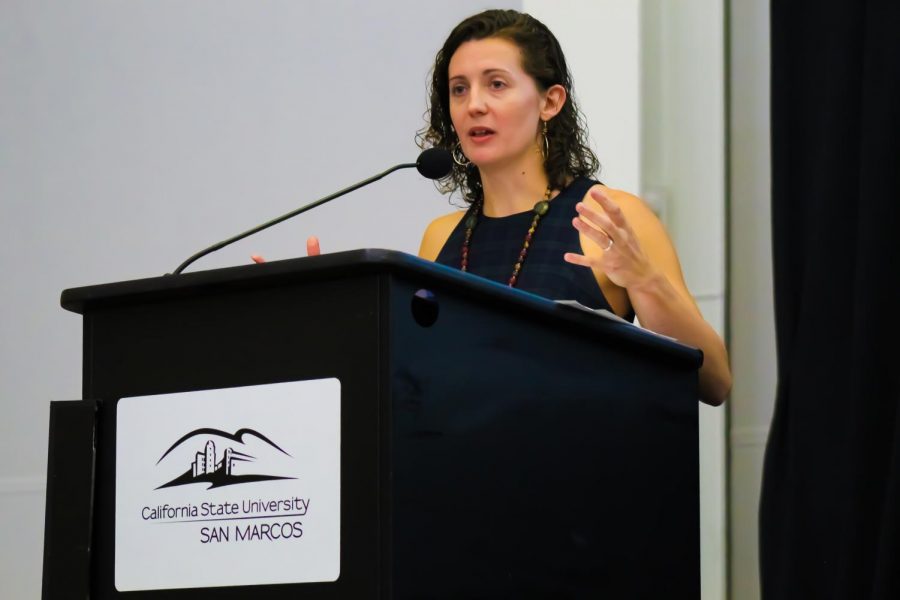Students hear perspective of immigration reporter
San Diego Tribune’s journalist, Kate Morrissey speaks to attendees during a Q&A session on October 23rd.
Hundreds of students filled the seats of the USU Ballroom to attend Deconstructing the Border: A Reporter’s Perspective, on the evening of Oct. 23.
Kate Morrissey, a journalist at the San Diego Union Tribune discussed her experience as an immigration reporter, which she had been working as since 2016.
The Cross-Cultural Center, DREAMer Resource Office and Latin@ Center sponsored the night’s event from 6 p.m. to 7:30 p.m., with the doors opening at 5:30 p.m. to begin seating the expected large audience. Deconstructing the Border was a part of the Cross-Cultural Center’s Critical Cougar Series, a series that is focused on addressing and educating students on cultural issues that impact the community.
After Morrissey’s introduction on describing her role as a journalist, she began to talk about the US Immigration System.
“The US Immigration System is incredibly complex,” said Morrissey, “There are an unlimited number of ways to immigrate here.”
Some of the ways to immigrate into the United States are by coming as a refugee, seeking asylum, with a work visa, student visa or by immigrating illegally. Morrissey said that many unauthorized immigrants illegally immigrate as a last resort when they are denied legal immigration or if the legal immigration process would take too long.
Applicants who want to immigrate to the US legally are often “waiting in this line, for years and years and years,” said Morrissey.
Morrissey also described the difference between a refugee and an asylum seeker. A refugee is someone who has been granted protection and asylum by a host country. An asylum seeker is someone who is in the process of waiting to be granted asylum, after entering the host country they are asking for asylum from. Refugees and asylum seekers fear persecution from their country of origin and have to be able to prove to the US government that they would be in danger if returned.
Morrissey also touched on issues such as metering, which the US government uses to control how many asylum seekers enter the US each day.
There are “10,000 people in Tijuana right now… they take in three to four people each day,” said Morrissey.
Metering by three to four people each day extends the process of granting asylum to three to four months.
Morrissey said that the majority of families are crossing illegally, because the process takes too long and that most of these families can’t wait three to four months, with the threat of deportation if they aren’t granted asylum.
“People are a lot of times fleeing something… depending on the country they’re from,” said Morrissey.
Asylum seekers often flee from gang violence, domestic violence and political oppression from their country of origin. In many cases, Morrissey said that they are at risk for torture and death.
Morrissey also discussed how the US asylum system has changed over the years.
“Because of Trump Administration policy, it’s not this way [the same] anymore,” said Morrissey, “if you cannot show that you are being persecuted… you’ll lose your case.”
She also mentioned how indigenous people would have a hard time going through the asylum system, because of the language barrier between the asylum seeker and authorities.
Morrissey said that now, a lot of asylum seekers are being sent back to Mexico.
Through slides in her PowerPoint, Morrissey showed pictures of individuals and families who are refugees and asylum seekers. The pictures of the people she showed came from different countries such as the Democratic Republic of the Congo, Guatemala, Mexico, South America and many other places from around the globe.
Morrissey said that she has followed the stories of these people during her time as an immigration reporter and has reported on their struggles through the immigration system. Some of those who have been granted asylum are now working or getting an education. Others have been denied and are still trying.
Once her presentation was over, Morrissey opened the floor to a Q&A so that students could ask further questions about her experience as an immigration reporter and about the US Immigration System.


